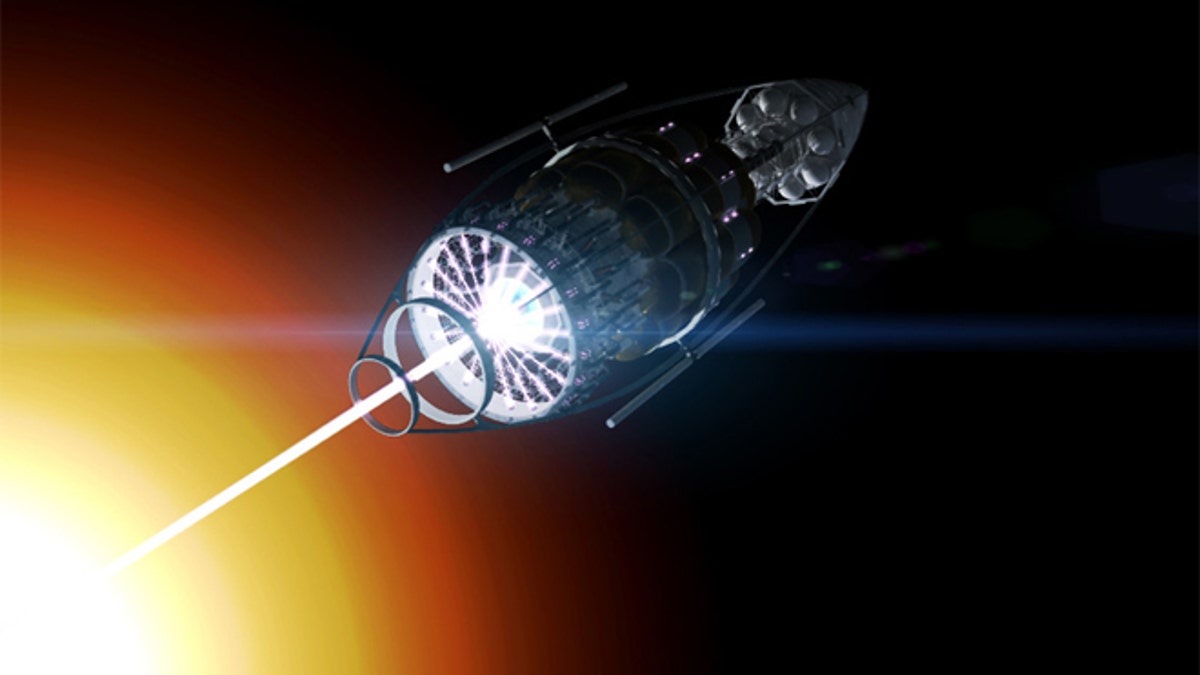
After charging its lasers using solar energy, the VARIES system fires-up, generating antimatter for the boost phase of an interstellar trek. (Adrian Mann/DiscoveryNews)
While interstellar journeys have been explored by researchers, one type of mission has not received much attention, namely the interstellar rendezvous and return mission that could be accomplished on timescales comparable with a working scientist's career.
Such a mission would involve an initial boost phase followed by a coasting phase to the target star system. Next would be the deceleration and rendezvous phase, which would be followed by a period of scientific data gathering.
Finally, there would be a second boost phase, aimed at returning the spacecraft back to the solar system, and subsequent coasting and deceleration phases upon return to our solar system.
Such a mission would represent a precursor to a future manned interstellar mission; which in principle could safely return any astronauts back to Earth.
PHOTOS: Sizing Up the Daedalus Interstellar Spacecraft
Interstellar missions have been proposed as a priority for research into the interstellar medium, studies of a target star, planetary science studies including moons and large asteroids, and astrobiological studies of any habitable planets that may exist.
Although exciting, the primary challenges associated with any interstellar mission relate to the distances involved. Voyager 1, launched in 1977, is the furthest manmade object from Earth, and travels at over 10 miles per second (36,000 mph). Even traveling at this incredible speed, it would take just over 70,000 years to reach the closest star to our solar system.
Recently, NASA began developing Solar Probe plus, which will study our own sun. Through a series of seven gravitational assists with the planet Venus, the probe will reach the extraordinary speed of 125 miles per second. This is a full seven times faster than Voyager 1, which would allow it to make a trip to another star (if that were its objective) in 6,450 years.
While this would still be an incredible accomplishment, no propulsion technology currently in existence has the capability to fly to another solar system on timescales comparable to a human lifetime.
This challenge becomes more apparent if we consider one of the simplest equations that governs spaceflight; the Tsiolkovsky rocket equation. Using this equation we find that to obtain the necessary speeds for an interstellar mission, exhaust speeds within an order of magnitude of the speed of light are necessary, as well as large mass ratios and large mass flow rates.
ANALYSIS: What Would an Interstellar 'Worldship' Look Like?
Because antimatter offers the highest possible energy density upon annihilating its matter counterpart, it is ideal for interstellar missions. In addition, the reaction occurs spontaneously and so does not require any complex reactor systems or bulky drivers to initiate the reaction.
One possibility for in-situ refueling that we introduce in this proposal is a quantum effect known as Schwinger pair production.
At all energies probed by experiments to date, the universe is accurately described as a set of quantum fields. Each mode of the vacuum behaves like a simple harmonic oscillator, and one quantum mechanical property of these oscillators is that their ground state exhibits fluctuations as a consequence of the Heisenberg Uncertainty Principle.
The vacuum is thus not devoid of matter or energy as classical physics would have us believe, but is instead a rich arena of quantum activity. Not long after Dirac's discovery that a relativistic description of electrons required the existence of positrons it was realized by Nobel Prize winning Physicist Julian Schwinger that that a strong enough electric field can create electron-positron pairs out of the vacuum of space itself.
For a laser intensity greater than some critical value, pair production is generated via a 'break-up' of the vacuum polarization. While the electric field strength necessary to accomplish this is immense, to say the least, recent experimental advances have raised hope that lasers may soon achieve field intensities on the order of this very critical field intensity.
For the VARIES concept, a starship would accelerate to the target solar system and decelerate using its onboard supply of fuel. At the target system, the starship would assume a stable orbit close to the systems star. Vast solar panels, hundreds of square miles in area would unfurl, and capture energy from the star. This sunlight would be converted into laser energy which would then be used to create antimatter from the vacuum of space via the Schwinger pair production mechanism.
HOWSTUFFWORKS: How Antimatter Spacecraft Will Work
Once a sufficient amount of antimatter is created and stored, the VARIES would then be adequately fueled to begin its return trip, presumably back to Earth, where it would then decelerate, allowing future interstellar explorers with a possible way to return to Earth.
One critical and unique component to the VARIES architecture is our proposal that proton-antiproton pair creation can be generated from the vacuum, given a sufficiently powerful electric field. Spontaneous particle creation from the vacuum by an external electric field has been applied to numerous problems in contemporary particle physics, including black hole quantum evaporation and electron-positron creation in the vicinity of charged black holes.
While this research is at a very early stage in its development, a peer reviewed article was recently published outlining the physics of the idea: Obousy, R.K., "Vacuum to Antimatter Rocket Interstellar Explorer System", JBIS 64 No.11/12 pp 378-386 (2011).
Richard Obousy is co-founder and President of Icarus Interstellar Inc., a nonprofit foundation dedicated to researching the science and technologies that will enable interstellar flight by 2100.
